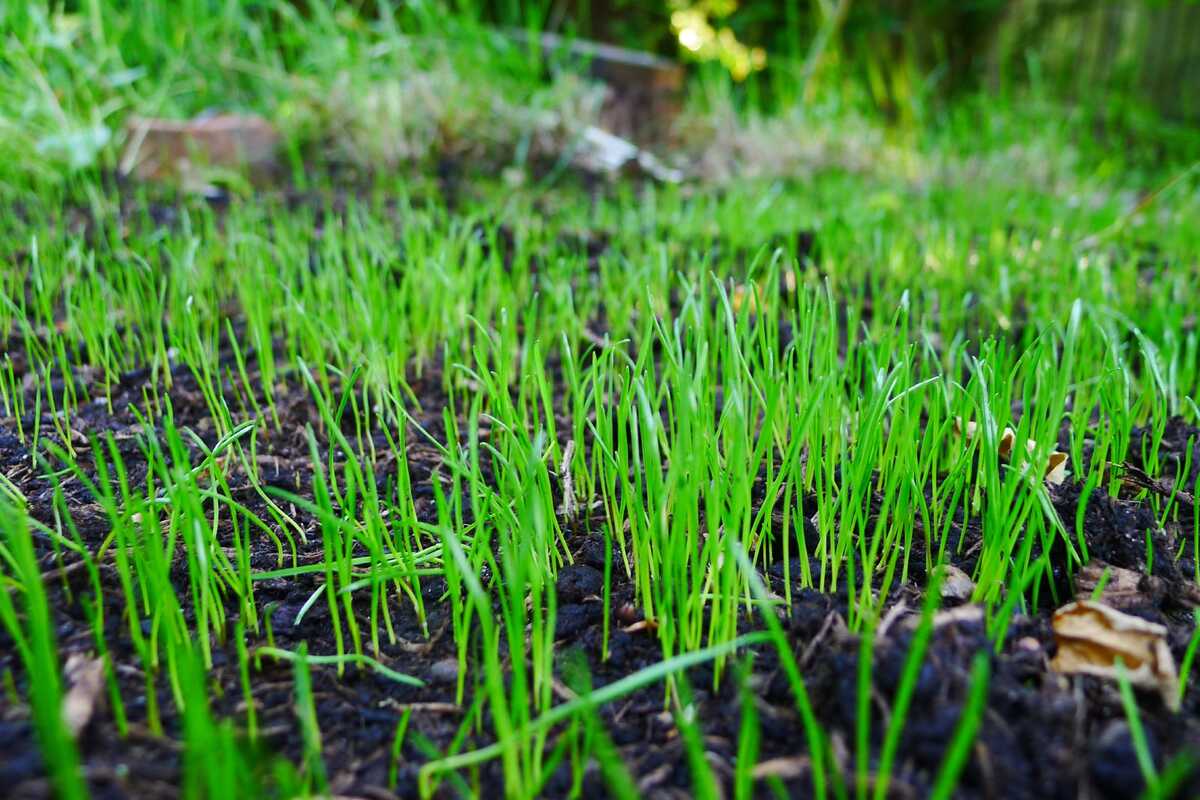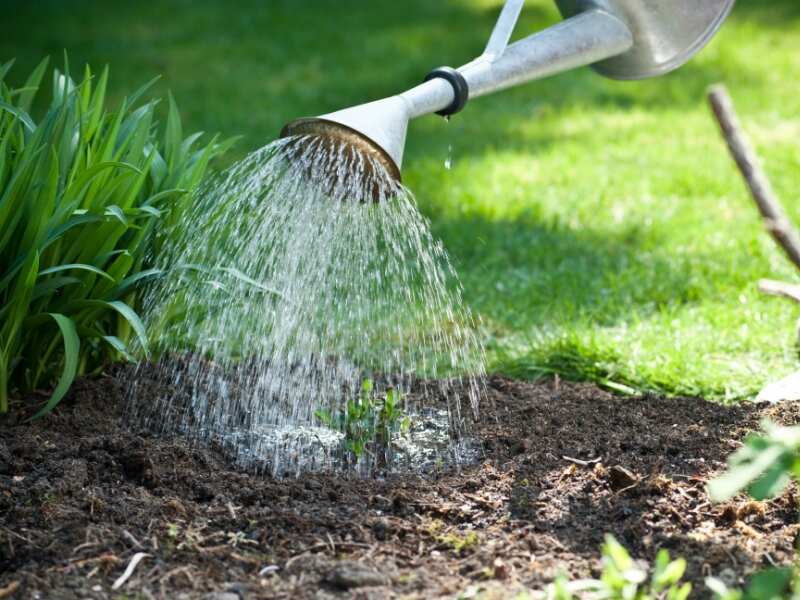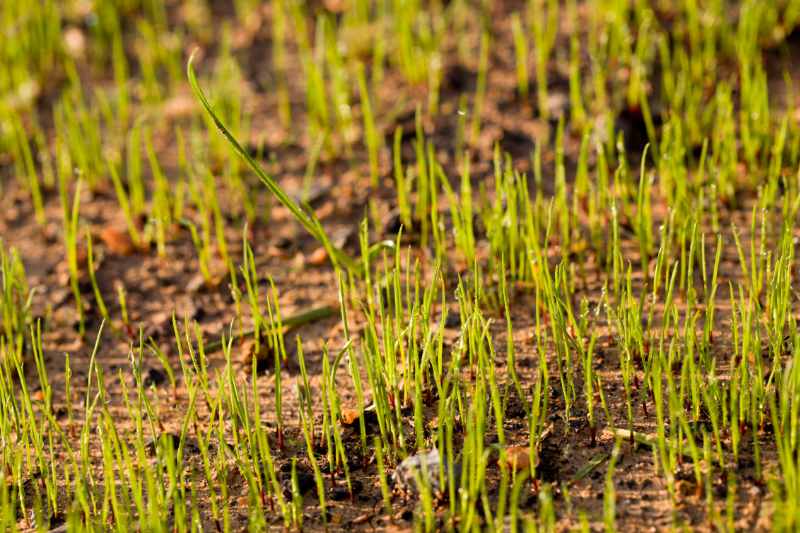
Knowing how often to water grass seed is essential for installing healthy turfgrass as a DIY project. Here’s the gist: New grass seed should be watered two to four times daily for 5 to 10 minutes to keep the top 1.5 inches of soil moist. In most climates, this watering schedule is followed for about one to two weeks until all grass seeds have sprouted.
Want to know more about watering new grass seeds? Read this article to learn how to adjust grass seed irrigation for sandy or clay soil, what other factors change the watering schedule, and practical tips to ensure your newly seeded lawn thrives.
Water the Soil Before Planting New Grass Seed
Water the ground several days before planting the grass seed. You want the soil to be soaked 6 to 8 inches deep. Soaking the ground before planting supports the germination process and deep root growth. It also helps disperse the nutrients from the starter fertilizer you must apply before seeding.
To ensure the soil has received enough water, push a screwdriver into the ground. It should easily penetrate the soil 6 to 8 inches deep. If the soil resists, it probably needs more water before you plant any seeds.
How Often and How Long to Water Grass Seed

The watering schedule for new grass seed depends on many factors, including the size of the area, type of grass seed, soil quality, and climate. In general, water new grass seeds two to four times a day for 5 to 10 minutes during the germination period. In most climates, grass seed germination takes about one to two weeks. Continue to water daily until all the grass seeds have sprouted.
First time watering the grass seed
After you spread the seeds and rake them lightly into the topsoil, follow these directions:
- Cover the newly seeded area with a thin layer of straw mulch to reduce water evaporation.
- Water the soil for 5 to 10 minutes to moisten the top 2 inches.
- Use a mist or oscillating nozzle to avoid large amounts of water dislodging grass seeds and prevent runoff.
- If watering manually with a garden hose, do your best to cover the entire lawn evenly.
When to water new grass seed: The best time of day to water new grass seeds is early morning, as this allows more moisture to penetrate the soil before evaporating. Water again in the late afternoon or early evening. During hot and windy days, schedule additional watering sessions to keep every seed moist enough to germinate.
Watering seeds during germination
Aim to keep the top 1.5 inches of soil moist during seed germination. Watering multiple times a day for short intervals is an excellent strategy to achieve this since it replenishes water loss through evaporation without overwatering. At this stage, the lawn should receive 3 to 4 inches of water per week or ⅛ to ¼ inches per day.
Irrigating a sprouted lawn
Grass develops stronger, deeper roots with infrequent watering. After most of your grass seeds have sprouted, reduce watering frequency and increase duration:
- Weeks 3 and 4: Reduce watering to one session daily and add a second during hot and dry days. At this early stage, grass has shallow roots and is highly vulnerable to drought stress.
- Weeks 5 and 6: Soak the area for about 40 minutes every other day, eventually reducing the watering schedule to two to three days a week. It is generally okay to miss a watering session after rainfall.
- Weeks 6 to 8: Your grass has established proper roots, and you can put it on a regular watering schedule. This means applying 1 to 1.5 inches of water weekly in one or two sessions.
Cool-season grass, like fine fescue or ryegrass, typically needs more water in hot weather.
Warm-season grasses, like Bahiagrass and Zoysiagrass, need less water to face the heat. They’ll also require you to turn the watering down a notch in the fall when they enter dormancy.
When to water sprouted grass: Prolonged leaf moisture at night is a sure recipe for fungal infestations, so avoid watering seedlings and established grass in the evening. The best time for lawn irrigation is between 6 a.m. and 10 a.m.
Note: Rainfall contributes to the amount of water the new grass seed receives. So ensure overall watering, including rainfall, is within the recommended amount. Unrooted seeds can be washed away if they are overwatered.
What Can Change the Grass Seed Watering Schedule

There are quite a few factors that can change the way you water grass seed. The most important are:
- Weather conditions: Heavy rain is a good reason to postpone irrigation for tomorrow, but light showers in the morning mean you’ll still need to water the seed bed in the sunny afternoon. A hot, dry spell should lead you to add an extra watering session, and so should high wind since it dries out the soil’s moisture.
- Type of soil: Clay soil is dense and holds much water. Two irrigation sessions might be enough on a regular day if you’re seeding on clay soil. Sandy soil has large particles and can’t hold water well. It dries out quickly, so plan to water more often to keep the grass seeds moist.
- Lawn slope: Water tends to run off toward the bottom of a sloped lawn. If you’re planting grass seed on a sloped area, keep an eye on the high part of the lawn and water more often if necessary.
- Sun exposure: Lawn areas directly exposed to sunlight lose water faster and require more frequent irrigation. Shady areas have a slower water evaporation rate and can be irrigated less often.
- Lawn sprinklers: Sprinkler flow rate varies with the sprinkler type and water pressure and determines how long you need to keep the system on. Make it a priority to know exactly how much water you’re putting on your seeded lawn to avoid overwatering and underwatering.
Overseeding vs. Reseeding Bare Patches vs. Seeding a New Lawn
How you water the new seeds spread on your lawn varies with the project you’re planning: overseeding, covering bare patches, or installing a new lawn from scratch.
How to water the overseeding of an existing lawn
Overseeding the lawn mixes new grass seed with already established turf. On the one hand, you need to keep the topsoil moist to ensure seed germination. On the other hand, you have to water deeply and less often to support deep rooting for your existing grass. Here’s how pros balance the two:
- Irrigate twice a day for 5 to 10 minutes to keep the new seeds moist
- Once a week, give the lawn a deep watering to keep the existing grass happy.
How to water when reseeding bare spots
With bare spots, the new seeds are spread inside a defined area, and established grass grows all around. The recommended way to water is like this:
- Irrigate the entire lawn as usual – once or twice a week with 1 to 1.5 inches of water
- Water the seeded patches two to four times daily with a garden hose or watering can. Apply ⅛ to ¼ inches of water until the seed germinates, then reduce the frequency.
How to water a newly seeded lawn
Irrigate two to four times daily when planting grass seed across the entire lawn. Apply ⅛ to ¼ inches of water a day in short sessions of 5 to 10 minutes.
How Long Does it Take for Grass Seed to Grow

Homeowners who have kept the soil and seeds moist should be rewarded with sprouting grass in about 10 to 14 days, as long as the conditions are ideal. Kentucky bluegrass may take longer to sprout, but grass blades should rear their pretty little heads in about 14 to 21 days.
If your grass is still playing hide-n-seek after this time period, it may be thirsty. Quench its thirst with more frequent watering.
Growth rates vary depending on different factors, including where you live, grass and soil type, and soil temperature. If you have a mixture of seeds, their varying characteristics will affect how quickly they grow. Here are the average germination times for the most common turf types to guide your watering schedule:
| Type of turf | Germination time |
| Annual ryegrass | 5 – 10 days |
| Bermudagrass (Seeded) | 10 – 30 days |
| Buffalograss | 14 – 30 days |
| Centipedegrass | 14 – 21 days |
| Colonial bentgrass | 10 – 14 days |
| Creeping bentgrass | 10 – 14 days |
| Fine fescue | 7 – 14 days |
| Kentucky bluegrass | 14 – 30 days |
| Perennial ryegrass | 5 – 10 days |
| St. Augustinegrass | 10 – 30 days |
| Tall fescue | 7 – 12 days |
| Zoysia | 14 – 21 days |
Grass plants don’t germinate all at once, even if you planted a single variety. Don’t let bare spots scare you just yet. Turf sprouts in patches of green depending on sun exposure and how deep the seed gets into the soil. Keep watering the grass to get that thick, healthy lawn you planned.
Tips to Ensure Proper Lawn Irrigation
Overwatering or underwatering turfgrass can hinder growth. Here are some tips for adequate watering:
- If you use a sprinkler system, choose one that distributes water evenly, like an oscillating sprinkler.
- Check the sprinkler system periodically to ensure it spreads water across the entire lawn. Adjust sprinkler heads, repair or replace broken sprinklers, and clean clogged nozzles.
- Keep the soil moist, but do not allow it to become soggy.
- Irrigate the seedbed at least three times a day when it is hot, sunny, and windy. Heat and wind dry out the lawn.
- As grass seedlings establish themselves, increase watering time in the mornings and reduce the time you water in the evenings.
- When grass nears mowing height, decrease the number of days you irrigate.
- Trees can absorb gallons of water from the ground daily, removing moisture from grass. Pay attention to seeded areas near trees. They might require more water.
- Watering infrequently and deeply in shady areas is crucial. Allow time for these areas to dry between irrigations to decrease disease risk.
- Do not mow wet grass.
FAQ About Watering Grass Seed
Can Grass Seed be Overwatered?
Yes, like fully mature gras, grass seeds also can be overwatered. When the soil around is soggy for a long time due to overwatering, seeds rot in the ground.
How Long Can Grass Seed Go Without Water?
Dormant grass seeds can go without water for months. But once you plant and water the seed and it starts germinating, it can only last a day or two without water, depending on the soil type and the weather.
What Are Signs the Grass Has Too Much Water?
Soggy soil or puddles are signs you are irrigating too much.
Leave the Seeding to a Pro and Enjoy the Green!
To ensure your grass seeds germinate successfully, you must provide the right water balance — enough to keep the soil and seeds moist but not so much that the seeds wash away or the soil becomes waterlogged. But why worry about getting every single detail right when you can leave the work to the professionals? LawnStarter can connect you to the best lawn care pros in your area who can establish and maintain a healthy, green lawn for you.
Main Photo Credit: Timo Newton-Syms / Flickr / CC BY-SA 2.0